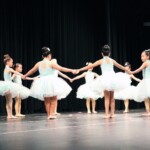The title of Prima Ballerina is a rare honor given to generation-defining female dancers of the highest caliber. Sometimes the title is used to designate the leading ballerina in a company, a much sought-after dancer who tours the world, or by a government as a cultural appointment of honor. The first dancers to be named “Prima Ballerina” were Italians in the late 19th century. While the United States has a number of world-renown dancers to their credit, including the likes of Misty Copland (pictured above) and Evelyn Cisneros, officially no ballerina from the USA has yet been awarded this prestigious title.
But great talent can come from anywhere, even Omaha, NE. And the next great Prima Ballerina, might just be your own child. Beware: a lot of time and energy goes into becoming the crème de la crème.
As a general rule, great talent, discipline, and skill come from 1,000 hours of mindful and diligent practice. Therefore, it’s smart to start early. At the Omaha School of Music and Dance, we have ballet classes for children as young as three, to start exploring the art form.
As the child grows older, they must acknowledge a passion, an excitement for dance, and find satisfaction expressing themselves through movement. One of our ballet instructors, Victoria, has observed ballet to be creatively therapeutic for kids—good for channeling excess energy. Ballet nourishes students’ strengths, and helps develop social skills through team-building.
As the determined young dancer grows, it’s important that great care be taken of their growing body. Ballet is very physically taxing: even minor injuries can hamper dreams of becoming a Prima Ballerina if not seen to early and properly.
And if your kid, at about 8 or 9 years old is passionate about dance, practicing at home, and begging for Swan Lake tickets, consider signing up for classes more than once a week. A future Prima Ballerina needs near-daily practice in order to strengthen and perfect form. Advanced dancers might attend class upwards of four or five days a week!
Once ankles become strong enough, usually around age 11 or 12, an instructor might consider training a young ballerina for pointe shoes—the beautiful engineering marvels with a flat toe box, which allow dancers to appear as if floating across the stage. With this accomplishment, more challenges are presented, as the physical feats of pirouettes and even the simple relevé gain a further level of difficulty.
If your young dancer is starting to get very serious about ballet, the teacher will have recognized the student’s efforts, and might assign them a solo role in a dance recital. Speak with one of OSMD’s dance instructors for further information for what the expectations are in order to unlock full Prima Ballerina potential. Even if a ballerina doesn’t start as a toddler, the teachers at the Omaha School of Music and Dance are ready to help explore a dancer’s full potential. Call 402-515-9639 to schedule ballet lessons today!
Ballet Classes for kids ages 6-9 years



